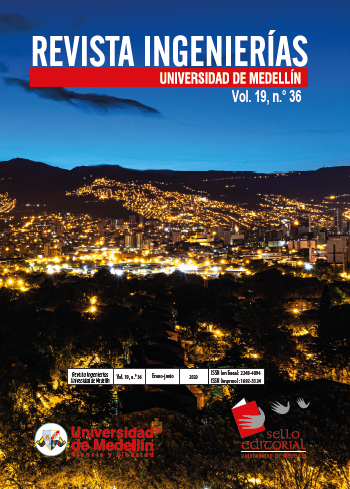Maze companion: artificial intelligence application that supports mazes solving
DOI:
https://doi.org/10.22395/rium.v19n36a5Keywords:
game companion, artificial intelligence, maze, processingAbstract
The concentration capabilities of a child depend on his or her age and the normal process is that along with their growth their attention span grows as well; nonetheless, it is important to work on this capability from a
young age. The classic board games such as chess, mazes, triqui, puzzles, etc. require a certain amount of mental processes in order to be played and are ideal for keeping the attention of the child for several minutes. This project is an innovative proposal through image processing and width search algorithms; it solves physical mazes created by the players. The obtained effectiveness was 72 %, remarking that the quality of the sensor and the angle in which the photograph is captured is of enormous influence.
Downloads
References
[1] F. Siebert, “Un tercio de los niños diagnosticados con déficit atencional son hijos de padres que lo padecieron - Universidad de Chileâ€, [En lÃnea], acceso 23 de marzo 2018; Disponible: http://www.uchile.cl/noticias/131342/origenes-y-pronostico-del-deficit-atencional-en-ninos
[2] C. Felfe y R. Lalive, “Does early child care affect children’s development?â€, J. Public Econ., vol. 159, pp. 33–53, [En lÃnea], acceso marzo 2018; Disponible:https://doi.org/10.1016/j.jpubeco.2018.01.014.
[3] “Juguetes de madera: beneficio de los laberintosâ€. [En lÃnea], acceso 23 marzo 2018; Disponible: https://juguetutto.com/blog/2016/01/29/por-que-regalar-laberintos-de-madera/
[4] A. Oren, “Children’s Use of Board Games in Psychotherapy†Journal of Child Psychotherapy, [En lÃnea], vol 34, pp. 364-383, dec. 2008; Disponible: http://dx.doi.org/10.1080/00754170 802472893
[5] J. P. Hinebaugh, A Board Game Education. Maryland, Estados Unidos: R&L Education, 2009.
[6] J. Begy, “Board Games and the Construction of Cultural Memoryâ€, Games Cult., 2015. [En lÃnea]; Disponible: https://doi.org/10.1177%2F1555412015600066
[7] W.-J. Chou, Y.-P. Chang, y C.-F. Yen, “Boredom proneness and its correlation with Internet addiction and Internet activities in adolescents with attention-deficit/hyperactivity disorderâ€, Kaohsiung J. Med. Sci., [En lÃnea], acceso febrero 2018; Disponible: https://doi.org/10.1016/j.kjms.2018.01.016
[8] C. F. Cortés, J. Giraldo, C. A. Pérez, A. Torres y C. A. Vega, “Móvil con búsqueda de trayectoria en laberintoâ€, Escuela Colombiana de IngenierÃa Julio Garavito. December 2008, 2015.
[9] M. O. A. Aqel, A. Issa, M. Khdair, M. ElHabbash, M. AbuBaker, and M. Massoud, “Intelligent Maze Solving Robot Based on Image Processing and Graph Theory Algorithmsâ€, in 2017 International Conference on Promising Electronic Technologies (ICPET), 2017, [En lÃnea], pp. 48–53; Disponible: https://doi.org/10.1109/ICPET.2017.15.
[10] “MAZE3D: Un juego de computadora para la estimulación de la orientación espacial / MAZE3D: A computer game for improve spatial orientation | Osorio Josué | RIDE Revista Iberoamericana para la Investigación y el Desarrollo Educativoâ€, [En lÃnea] acceso 24 marzo 2018; Disponible: https://www.ride.org.mx/index.php/RIDE/article/view/147/646https://doi.org/10.23913/ride.v6i11.147.
[11] J. Grompone, El paradigma del laberinto, Montevideo, Uruguay: La Flor del Itapebi, 2011.
[12] C. Jarvis, “Active Launceston launches Active Technology at East Tamar Primary Schoolâ€, The Examiner News, n.°, 2017, [En lÃnea], acceso 24 marzo 2018; Disponible: https://www.examiner.com.au/story/4641347/technology-used-to-inspire-active-kids/
[13] M. Azizinezhad y M. Hashemi, “Technology as a Medium for Applying Constructivist Teaching Methods and Inspiring Kidsâ€, Procedia - Soc. Behav. Sci., [En lÃnea], vol. 28, pp. 862–866, acceso enero 2011; Disponible: htt ps://doi.org/10.1016/j.sbspro.2011.11.158
[14] S. Hojjat, C. Fukuzaki, y T. Sowa, “Maze and Mirror Game Design for Increasing Motivation in Studying Science in Elementary School Studentsâ€, 2017, [En lÃnea], pp. 55–64; Disponible: http://dx.doi.org/10.1007/978-3-319-55834-9_7
[15] J. A. Verkhoturova, J. N. Galaguzova, y N. N. Sergeeva, “The Technique of Game Skills Development for Parents Raising Young Childrenâ€, Procedia - Soc. Behav. Sci., [En lÃnea], vol. 233, pp. 150-154, acceso octubre 2016; Disponible: https://doi.org/10.1016/j.sbspro.2016.10.174
[16] V. F. Gabdulkhakov, “A Didactic Game Technologyâ€, Procedia - Soc. Behav. Sci., [En lÃnea], vol. 233, pp. 170–174, acceso octubre 2016; Disponible: htt ps://doi.org/10.1016/j.sbspro.2016.10.187
[17] C. T. Leondes, Image Processing and Pattern Recognition, San Diego, Estados Unidos: Academic Press, 1998.
[18] S. Jayaraman, Digital Image Processing. Tata McGraw-Hill Education, 2011.
[19] A. Zelinsky, “Learning OpenCV-Computer Vision with the OpenCV Library (Bradski, G.R. et al.; 2008) [On the Shelf]â€, IEEE Robot. Autom. Mag., [En lÃnea], vol. 16, n.° 3, p. 100, 2009; Disponible: https://doi.org/10.1109/MRA.2009.933612.
[20] S. Kagami, “Utilizing OpenCV for High-Speed Vision Processingâ€, Adv. Robot., [En lÃnea], vol. 31, n.° 3, pp. 244–248, 2013; Disponible: https://doi.org/10.7210/jrsj.31.244
[21] N. J. Nilsson, Inteligencia artificial: una nueva sÃntesis, Madrid, España: Mc Graw Hill, 2001.
[22] A. GarcÃa, Inteligencia artificial: fundamentos, práctica y aplicaciones. Madrid, España: RC Libros, 2012.
[23] A. Freeman, “Creating Mobile Web Appsâ€, Pro JavaScript for Web Apps, 2012, [En lÃnea], pp. 195–228; Disponible: htt ps://doi.org/10.1007/978-1-4302-4462-2_8
Downloads
Published
How to Cite
Issue
Section
License
The total or partial reproduction of the contents of the journal for educational, research, or academic purposes is authorized as long as the source is cited. For reproduction for other purposes, express authorization from the Sello Editorial Universidad de MedellÃn is required.

